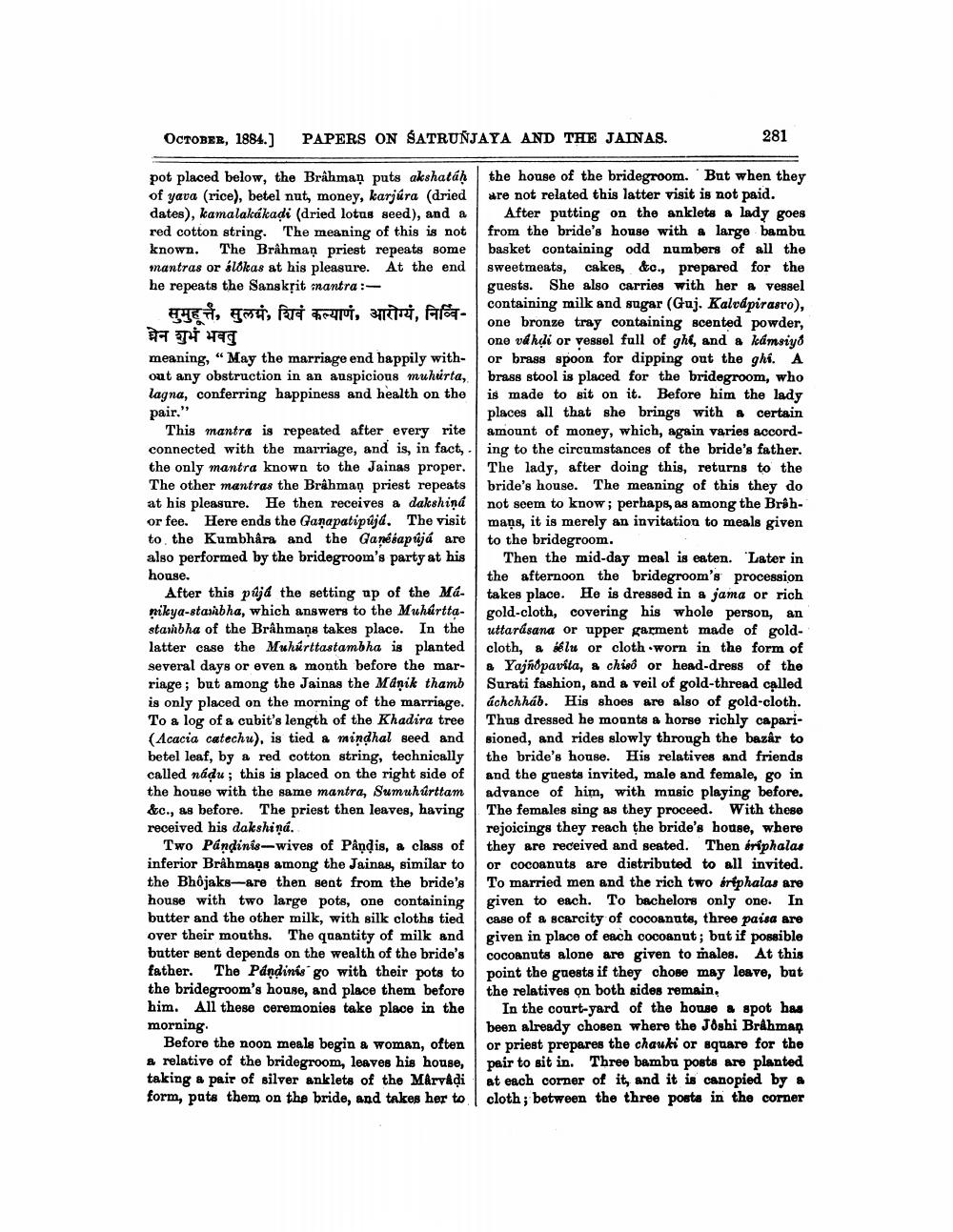________________
OCTOBER, 1884.]
PAPERS ON ŠATRUNJAYA AND THE JAINAS.
281
pair."
pot placed below, the Brâhman puts akshatáh the house of the bridegroom. But when they of yava (rice), betel nut, money, karjúra (dried are not related this latter visit is not paid. dates), kamalakakadi (dried lotus seed), and a 1 After putting on the anklets a lady goes red cotton string. The meaning of this is not from the bride's house with a large bambu known. The Brâhmaņ priest repeats some basket containing odd numbers of all the mantras or álókas at his pleasure. At the end sweetmeats, cakes, &c., prepared for the he repeats the Sansksit mantra:
guests. She also carries with her & vessel
containing milk and sugar (Guj. Kalvdpirasro), सुमुहूर्त, सुलमं, शिवं कल्याणं, आरोग्य, निवि
one bronze tray containing scented powder, घेन शुभं भवतु
one váhdi or veggel full of ghé, and a kámsiyo meaning, "May the marriage end happily with- or brass spoon for dipping out the ghi. A out any obstruction in an auspicious muhurta, brass stool is placed for the bridegroom, who lagna, conferring happiness and health on the is made to sit on it. Before him the lady
places all that she brings with a certain This mantra is repeated after every rite amount of money, which, again varies accordconnected with the marriage, and is, in fact, ing to the circumstances of the bride's father. the only mantra known to the Jainas proper. The lady, after doing this, returns to the The other mantras the Brāhmaṇ priest repeats bride's house. The meaning of this they do at his pleasure. He then receives a dakshina not seem to know; perhaps, as among the Brahor fee. Here ends the Ganapatipuja. The visit maņs, it is merely an invitation to meals given to the Kumbhåra and the Ganesapujá are to the bridegroom. also performed by the bridegroom's party at his Then the mid-day meal is eaten. 'Later in house.
the afternoon the bridegroom's procession After this pujd the setting up of the Ma. takes place. He is dressed in a jama or rich milya-stanbha, which answers to the Muhártta- gold-cloth, covering his whole person, an stavbha of the Brâhmans takes place. In the uttardsana or upper garment made of goldlatter case the Muhárttastambha is planted cloth, a blu or cloth.worn in the form of several days or even a month before the mar- & Yajnopavita, & chis or head-dress of the riage; but among the Jainas the Manik thamb Surati fashion, and a veil of gold-thread called is only placed on the morning of the marriage. áchchháb. His shoes are also of gold-cloth. To a log of a cubit's length of the Khadira tree Thus dressed he mounts a horse richly capari(Acacia catechu), is tied a mindhal seed andsioned, and rides slowly through the bazár to betel leaf, by a red cotton string, technically the bride's house. His relatives and friends called nádu; this is placed on the right side of and the guests invited, male and female, go in the house with the same mantra, Sumuhurttam advance of him, with music playing before. &c., as before. The priest then leaves, having The females sing as they proceed. With these received his dakshina.
rejoicings they reach the bride's house, where Two Pándinis--wives of Pandis, a class of they are received and seated. Then briphalas inferior Brahmaps among the Jainas, similar to or cocoanuts are distributed to all invited. the Bhôjaks-are then sent from the bride's To married men and the rich two árfphalas are house with two large pots, one containing given to each. To bachelors only one. In butter and the other milk, with silk cloths tied case of a scarcity of cocoanuts, three paisa are over their mouths. The quantity of milk and given in place of each cocoannt; but if possible butter sent depends on the wealth of the bride's cocoanuts alone are given to males. At this father. The Pándinis go with their pots to point the guests if they chose may leave, but the bridegroom's house, and place them before the relatives on both sides remain. him. All these ceremonies take place in the In the court-yard of the house a spot has morning
been already chosen where the Joshi Brahman Before the noon meals begin a woman, often or priest prepares the chauki or square for the a relative of the bridegroom, leaves his house, pair to sit in. Three bambu posts are planted taking a pair of silver anklets of the Marviņi at each corner of it, and it is canopied by a form, pats them on the bride, and takes her to cloth ; between the three posts in the corner




